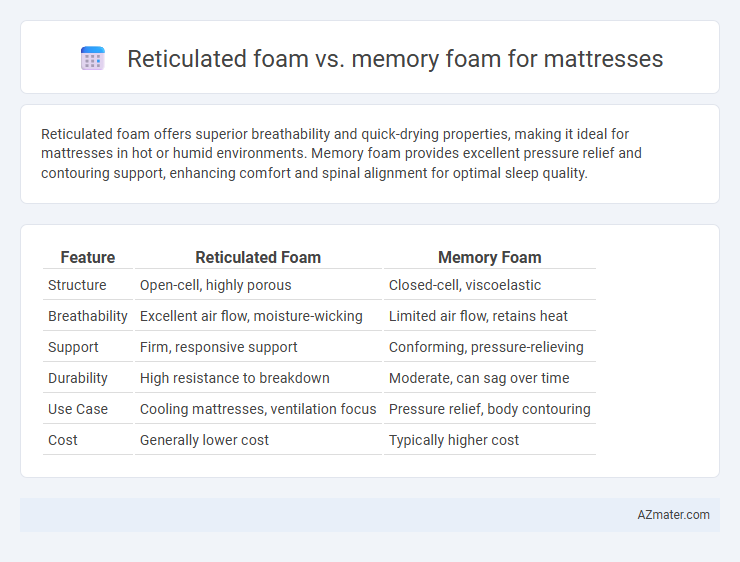Reticulated foam offers superior breathability and quick-drying properties, making it ideal for mattresses in hot or humid environments. Memory foam provides excellent pressure relief and contouring support, enhancing comfort and spinal alignment for optimal sleep quality.
Table of Comparison
| Feature | Reticulated Foam | Memory Foam |
|---|---|---|
| Structure | Open-cell, highly porous | Closed-cell, viscoelastic |
| Breathability | Excellent air flow, moisture-wicking | Limited air flow, retains heat |
| Support | Firm, responsive support | Conforming, pressure-relieving |
| Durability | High resistance to breakdown | Moderate, can sag over time |
| Use Case | Cooling mattresses, ventilation focus | Pressure relief, body contouring |
| Cost | Generally lower cost | Typically higher cost |
Introduction to Mattress Foams
Reticulated foam features an open-cell structure that promotes exceptional airflow and quick moisture dissipation, making it ideal for sleep environments that require breathability and durability. Memory foam, known for its viscoelastic properties, contours precisely to body shape, offering pressure relief and support by responding to heat and weight. Choosing between reticulated foam and memory foam depends on factors like ventilation needs, comfort preference, and mattress longevity.
What is Reticulated Foam?
Reticulated foam is a type of open-cell polyurethane foam characterized by a network of interconnected pores that allow maximum airflow and quick moisture evaporation, making it ideal for mattress layers where breathability is crucial. Unlike memory foam, which contours closely to the body and retains heat due to its dense structure, reticulated foam provides durable support with enhanced ventilation, reducing heat buildup and promoting a cooler sleep environment. Its unique porous design is often used in mattress comfort and support layers to improve pressure relief while maintaining firmness and durability.
What is Memory Foam?
Memory foam is a viscoelastic polyurethane material known for its ability to conform to the body's shape, providing pressure relief and support by responding to heat and weight. It is popular in mattresses for its contouring properties that reduce pressure points and improve spinal alignment. Unlike reticulated foam, which is open-cell and designed for breathability and durability, memory foam offers a slower response to movement, enhancing comfort through its unique viscoelastic characteristics.
Key Differences: Reticulated vs Memory Foam
Reticulated foam features an open-cell structure allowing superior airflow and quick drying, making it ideal for breathable mattress layers and enhanced cooling support. Memory foam is denser, offering contouring comfort by conforming closely to body shape, reducing pressure points and providing significant motion isolation. Key differences include reticulated foam's enhanced ventilation versus memory foam's superior cushioning and heat retention properties.
Breathability and Airflow Comparison
Reticulated foam offers superior breathability and airflow due to its open-cell structure, allowing air to circulate freely and dissipate heat effectively. Memory foam, while conforming closely to the body, tends to retain heat because of its dense composition, which can limit airflow and cause warmth during sleep. For mattress users prioritizing ventilation and a cooler sleep environment, reticulated foam provides enhanced temperature regulation compared to memory foam.
Comfort and Support Levels
Reticulated foam offers superior breathability and firm support, making it ideal for sleepers who prefer a cooler and more resilient mattress surface. Memory foam contours closely to the body, providing exceptional pressure relief and cushioning, which enhances comfort but may retain heat. Choosing between reticulated and memory foam depends on the desired balance between support firmness and conforming comfort for optimal sleep quality.
Durability and Longevity
Reticulated foam offers superior durability due to its open-cell structure, which enhances breathability and maintains resilience over time, making it ideal for mattresses requiring long-lasting support. Memory foam, while known for its contouring comfort, tends to undergo faster wear and sagging, especially in high-density variations, reducing its overall lifespan. Choosing reticulated foam extends mattress longevity through better airflow and consistent pressure distribution, outperforming memory foam in durability metrics.
Allergens and Hygiene Factors
Reticulated foam offers superior airflow and drainage, significantly reducing moisture buildup and minimizing the growth of allergens such as dust mites and mold, making it ideal for allergy sufferers. Memory foam, while providing excellent contouring support, tends to retain heat and moisture, which can create an environment conducive to allergen accumulation if not properly ventilated. Choosing reticulated foam mattresses enhances hygiene by promoting breathability and quick drying, contributing to a healthier sleep surface for sensitive individuals.
Ideal Sleepers for Each Foam Type
Reticulated foam offers exceptional breathability and durability, making it ideal for hot sleepers and those requiring strong edge support or enhanced airflow. Memory foam contours closely to the body, providing pressure relief and motion isolation, which suits side sleepers and individuals with joint pain or back issues. Selecting between reticulated and memory foam depends on sleeper preferences for temperature regulation, support, and body contouring needs.
Choosing the Best Foam for Your Mattress
Reticulated foam offers superior airflow and durability, making it ideal for mattress users seeking a cooler sleeping experience and enhanced mattress longevity. Memory foam provides excellent body contouring and pressure relief, which benefits those with joint pain or who prefer a more conforming surface. When choosing the best foam for your mattress, consider your temperature preferences, support needs, and any specific health concerns to select between the breathable, resilient structure of reticulated foam or the adaptive comfort of memory foam.

Infographic: Reticulated foam vs Memory foam for Mattress
 azmater.com
azmater.com